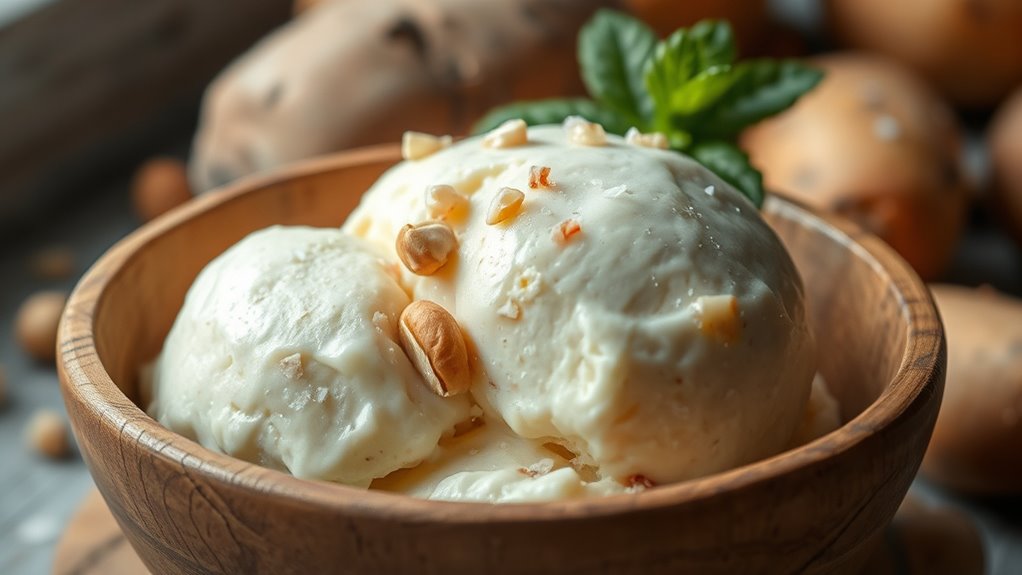A potato ice cream recipe uses a creamy dairy base with mashed potatoes for body and a neutral flavor that won’t overwhelm sweet elements. Start with chilled dairy, gently warm the potato base, then slowly temper it into the dairy to keep an emulsion. Stabilizers or a touch of starch help prevent lumps. Chill before serving and consider subtle toppings like toasted nuts. If you keep exploring, you’ll uncover nuanced texture and aroma adjustments you can try.
Ingredients and Quantity
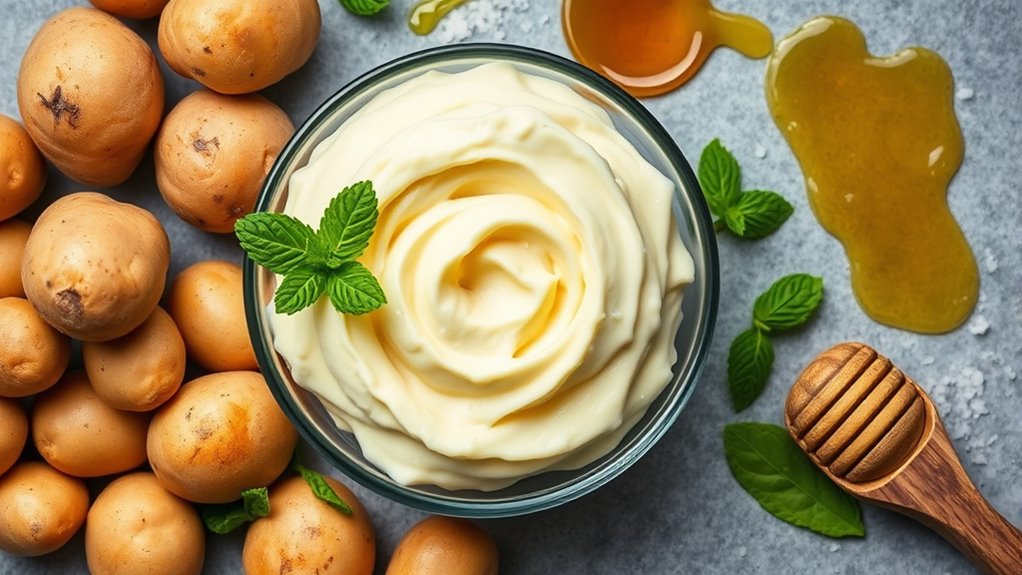
To craft a potato ice cream, you’ll need a concise set of ingredients that blend dairy, potatoes, and stabilizers: 2 cups of mashed potato (room temperature), 1 cup heavy cream, 1/2 cup whole milk, 1/3 cup sugar, 1/4 teaspoon salt, 1 teaspoon vanilla extract, and optional stabilizers like 1 tablespoon starch (such as cornstarch) or 1/2 teaspoon guar gum.
| Ingredient | Amount |
|---|---|
| Mashed potato | 2 cups |
| Heavy cream | 1 cup |
| Whole milk | 1/2 cup |
| Sugar | 1/3 cup |
| Salt | 1/4 tsp |
| Vanilla | 1 tsp |
| Stabilizers | optional |
Potato varieties and flavor combinations guide choice, balancing sweetness, dairy, and texture for a controlled, freedom-minded result.
Preparations
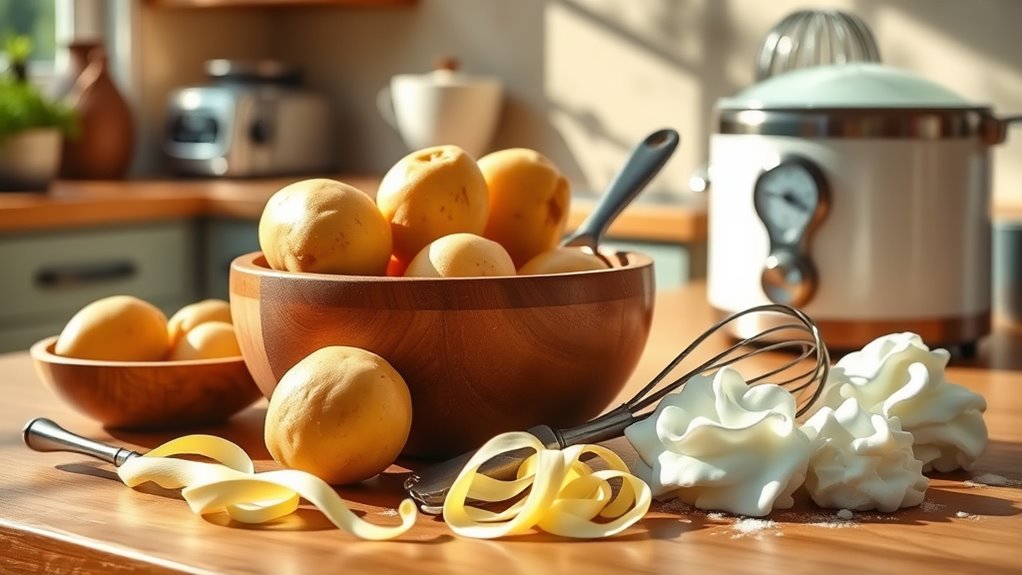
Preparing the potato ice cream base starts with tempering and blending the ingredients to guarantee a smooth, cohesive mixture. You’ll focus on potato selection to confirm a clean flavor and stable texture, avoiding earthy notes that can skew sweetness. Begin with chilled dairy or dairy alternatives, then gradually incorporate potatoes to minimize lumps. Tempering helps maintain emulsion, so you preserve a creamy mouthfeel rather than a grainy bite. As you blend, monitor fat and sugar balance to support reliable ice cream texture. Use measured timings for each step, stopping before over-processing to prevent airiness from compromising structure. Record observations about texture and aroma to guide adjustments in future batches, keeping the process efficient and grounded in evidence.
How to Cook
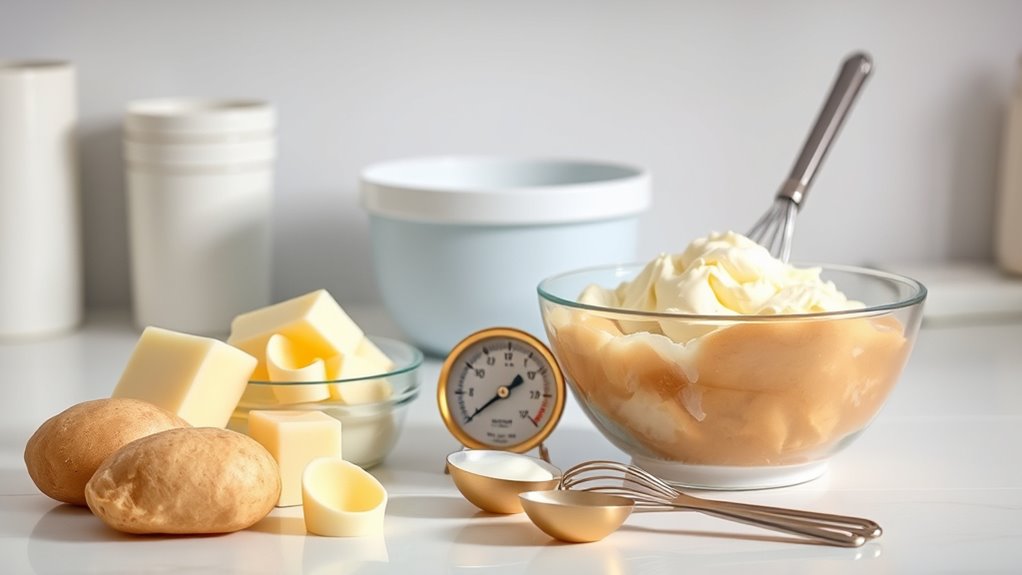
- Organize your cooking setup by gathering cold dairy or dairy alternatives, the pre-cooked potato base, and any stabilizers or flavorings you plan to use.
- Ensure all ingredients are clean and measured accurately.
- Have a reliable thermometer ready for monitoring temperature.
- Warm the potato base gently to avoid overheating.
- Temper the base with dairy slowly to prevent curdling, maintaining steady agitation.
- Incorporate stabilizers as directed, mixing thoroughly to achieve smooth integration.
- Chill the mixture after incorporating stabilizers.
- Choose balanced flavor combinations that complement the starchiness of potatoes without overpowering it.
- Monitor temperature, viscosity, and sweetness carefully, making gradual adjustments as needed.
- Use measured churning intervals to avoid over-incorporation, which can cause unwanted air or ice crystallization.
- Evaluate texture by tasting small test scoops.
- Document all adjustments for reference in future batches.
- Follow evidence-based cooking techniques while allowing room for controlled experimentation.
How to Serve

After the ice cream base is churned to a smooth, scoopable state, consider serving options that highlight the potato’s texture without masking it. You’ll want contrast: a crisp element, like salted caramel shards or toasted nuts, paired with a mint or citrus nuance to sharpen the profile. Choose temperatures thoughtfully: a slightly warmer plate can awaken nuances, while a cold scoop preserves creaminess. For presentation ideas, present in shallow bowls to expose color and texture, or use a simple quenelle on a matte surface to emphasize smoothness. Serving suggestions should balance sweetness with earthy notes, avoiding heavy toppings that overwhelm flavor. Keep portions moderate and garnish sparingly to support, not overshadow, the potato base. Presentation ideas align with the dish’s delicate texture and your freedom to explore.
Tips
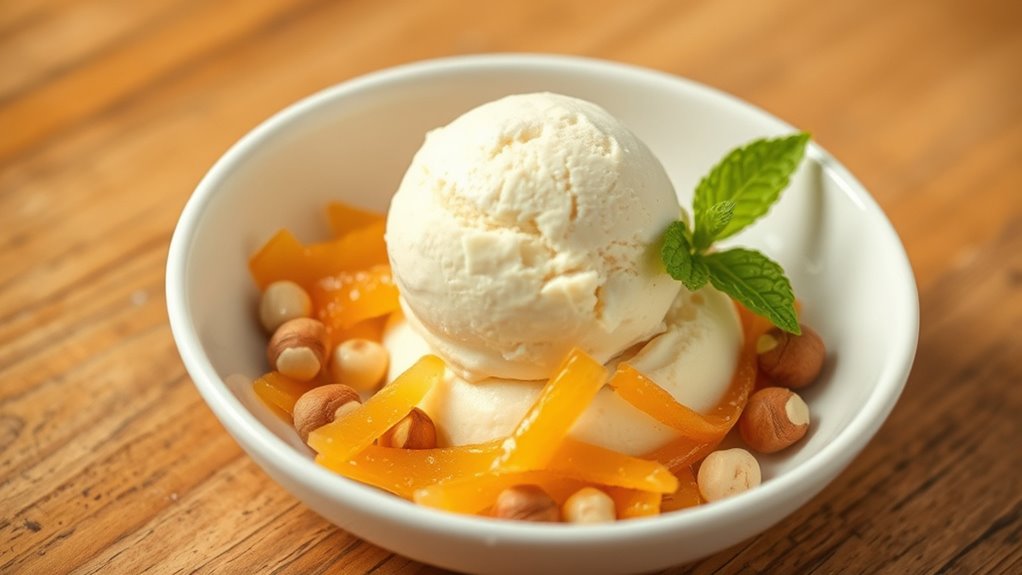
To get the best potato ice cream, keep your base smooth and stable by using well-scanned potatoes, a balanced fat-to-water ratio, and careful temperature control during mixing and freezing. You’ll benefit from chilling your cream base before churning to reduce thermal shock, and you should monitor viscosity to avoid over-thickening. Use precise measurements and record small adjustments, so results are repeatable. Consider gentle emulsification to improve texture without introducing air pockets. When you finish, rest the churned mix briefly in the freezer to firm without crystallizing. For flavor exploration, pursue creative toppings and flavor variations that complement the potato base rather than overwhelm it, keeping sweetness in balance with dairy richness. Consistency and restraint support reliable, adaptable outcomes.
Food Value and Benefit
Potato ice cream offers a distinctive dairy-based dessert with notable nutritional value and benefits when enjoyed as part of a balanced diet. This recipe provides energy primarily from carbohydrates and some protein, with nutritional content varying based on specific ingredients and portion size.
Benefits of eating this recipe include:
Potato ice cream delivers minerals, protein, and fiber within a balanced, satisfying dairy-based treat.
- Provides essential minerals such as potassium and magnesium from potatoes
- Contains calcium and phosphorus from dairy ingredients, supporting bone health
- Supplies dietary fiber if whole potato or other whole-food add-ins are included, aiding digestion
- Offers a moderate amount of protein to contribute to daily intake
- Contains vitamins such as vitamin C (from potatoes) and B vitamins (from dairy)
- Balanced fat content that can influence satiety and energy levels
Frequently Asked Questions
How Long Can Potato Ice Cream Be Stored?
In your kitchen, you can store it for about 1 to 2 weeks frozen, and 2 to 3 days soft in the fridge. Follow storage tips, monitor texture, and note shelf life for best flavor and safety.
Can I Freeze It Without an Ice Cream Maker?
Yes, you can freeze it without a maker using freezing methods that minimize ice crystals; blend, churn briefly, then freeze. For best texture, choose starchy potato varieties, and portion promptly to reduce freezer burn risks.
What Substitutes Work for Dairy-Free Versions?
Creamy substitutes exist: coconut milk and almond milk work, especially when blended with a dairy-free fat like coconut oil; use xanthan gum for texture. You’ll get a smoother, dairy-free result without sacrificing freedom or balance.
Will Adding Sugar Affect Texture or Melt Rate?
Yes, adding sugar affects texture and melt rate. Sugar impact slows ice crystal growth, improving scoopability, while higher levels can tacky or create a softer texture. Texture changes depend on concentration, fat, and stabilizers; balance for preferred freedom.
Is There a Traditional Flavor Profile for This Dessert?
Traditional profiles exist but vary; you’ll find balance between sweet, savory, and earthy notes. You’ll notice traditional ingredients like dairy and starch, with careful flavor balance guiding submissions. You crave freedom, yet stay evidence-based and precise in adjustments.
